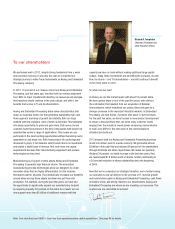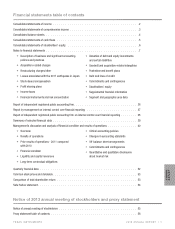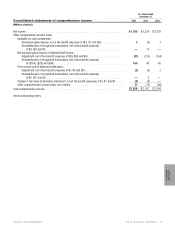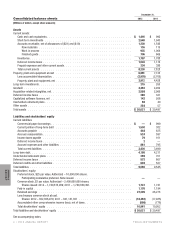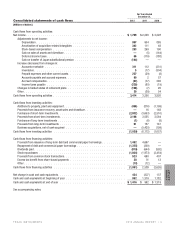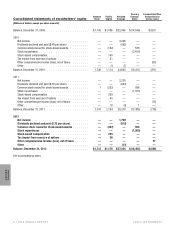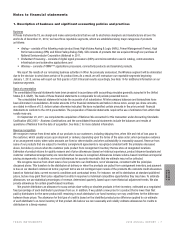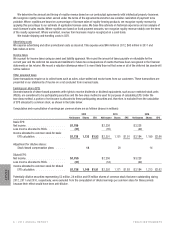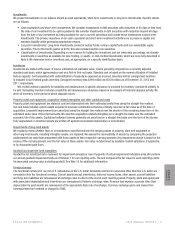Texas Instruments 2012 Annual Report Download - page 11
Download and view the complete annual report
Please find page 11 of the 2012 Texas Instruments annual report below. You can navigate through the pages in the report by either clicking on the pages listed below, or by using the keyword search tool below to find specific information within the annual report.
ANNUAL
REPORT
TEXAS INSTRUMENTS 2012 ANNUAL REPORT • 9
Investments
We present investments on our balance sheets as cash equivalents, short-term investments or long-term investments. Specific details
are as follows:
• Cash equivalents and short-term investments: We consider investments in debt securities with maturities of 90 days or less from
the date of our investment to be cash equivalents. We consider investments in debt securities with maturities beyond 90 days
from the date of our investment as being available for use in current operations and include these investments in short-term
investments. The primary objectives of our cash equivalent and short-term investment activities are to preserve capital and
maintain liquidity while generating appropriate returns.
• Long-term investments: Long-term investments consist of mutual funds, venture capital funds and non-marketable equity
securities. Prior to the fourth quarter of 2012, this also included auction-rate securities.
• Classification of investments: Depending on our reasons for holding the investment and our ownership percentage, we classify
investments in securities as available for sale, trading, or equity- or cost-method investments, which are more fully described in
Note 9. We determine cost or amortized cost, as appropriate, on a specific identification basis.
Inventories
Inventories are stated at the lower of cost or estimated net realizable value. Cost is generally computed on a currently adjusted
standard cost basis, which approximates cost on a first-in first-out basis. Standard cost is based on the normal utilization of installed
factory capacity. Cost associated with underutilization of capacity is expensed as incurred. Inventory held at consignment locations
is included in our finished goods inventory. Consigned inventory was $169 million and $129 million as of December 31, 2012 and
2011, respectively.
We review inventory quarterly for salability and obsolescence. A specific allowance is provided for inventory considered unlikely to
be sold. Remaining inventory includes a salability and obsolescence allowance based on an analysis of historical disposal activity. We
write off inventory in the period in which disposal occurs.
Property, plant and equipment; acquisition-related intangibles and other capitalized costs
Property, plant and equipment are stated at cost and depreciated over their estimated useful lives using the straight-line method.
Our cost basis includes certain assets acquired in business combinations that were initially recorded at fair value as of the date of
acquisition. Leasehold improvements are amortized using the straight-line method over the shorter of the remaining lease term or the
estimated useful lives of the improvements. We amortize acquisition-related intangibles on a straight-line basis over the estimated
economic life of the assets. Capitalized software licenses generally are amortized on a straight-line basis over the term of the license.
Fully depreciated or amortized assets are written off against accumulated depreciation or amortization.
Impairments of long-lived assets
We regularly review whether facts or circumstances exist that indicate the carrying values of property, plant and equipment or
other long-lived assets, including intangible assets, are impaired. We assess the recoverability of assets by comparing the projected
undiscounted net cash flows associated with those assets to their respective carrying amounts. Any impairment charge is based on the
excess of the carrying amount over the fair value of those assets. Fair value is determined by available market valuations, if applicable,
or by discounted cash flows.
Goodwill and indefinite-lived intangibles
Goodwill is not amortized but is reviewed for impairment annually or more frequently if certain impairment indicators arise. We perform
our annual goodwill impairment tests as of October 1 for our reporting units. The test compares the fair value for each reporting unit to
its associated carrying value including goodwill. See Note 10 for additional information.
Foreign currency
The functional currency for our non-U.S. subsidiaries is the U.S. dollar. Accounts recorded in currencies other than the U.S. dollar are
remeasured into the functional currency. Current assets (except inventories), deferred income taxes, other assets, current liabilities
and long-term liabilities are remeasured at exchange rates in effect at the end of each reporting period. Property, plant and equipment
with associated depreciation and inventories are remeasured at historic exchange rates. Revenue and expense accounts other than
depreciation for each month are remeasured at the appropriate daily rate of exchange. Currency exchange gains and losses from
remeasurement are credited or charged to OI&E.


